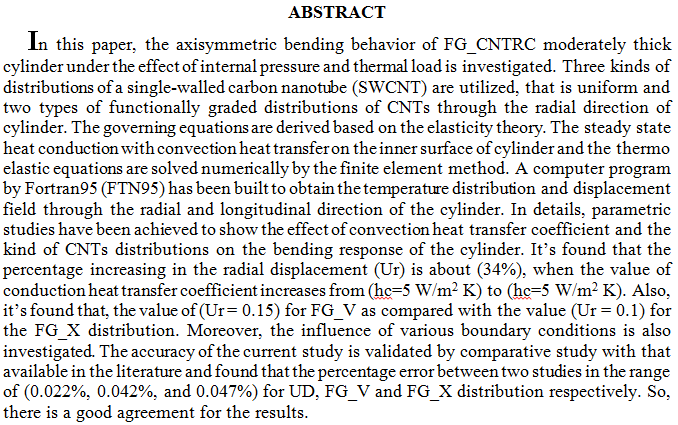
In this study, the surface of the epoxy/Al composite is treated using a dielectric barrier discharge (DBD) plasma in the presence of air. The epoxy composite was prepared by mixing 0.1g and 0.3 g aluminum powder with epoxy resin and its hardener in a ratio of 3:1. The surface epoxy/Al composite as a dielectric barrier layer (DB) is studied at an applied frequency of 8 kHz and at three exposure times 0, 2, and 4 min. The UV degradation process has been studied using UV-Visible spectroscopy, for these polymers. The absorbance intensity in the UV region (200–320 nm) was high. The absorbance level decreased after 2 minutes and increased after 4 min exposure time. Before exposure to plasma, the epoxy/Al composite at 0.1 g Al ha
... Show More (2)
(2)
In this study, the effect of glass fiber reinforced polymer (GFRP) section and compressive strength of concrete in composite beams under static and low velocity impact loads was examined. Modeling was performed and the obtained results were compared with the test results and their compatibility was evaluated. Experimental tests of four composite beams were carried out, where two of them are control specimen with 20 MPa compressive strength of concrete deck slab and 50 MPa for other. Bending characteristics were affected by the strength of concrete under impact loading case, as it increased maximum impact force and damping time at a ratio of 59% and reduced the damping ratio by 47% compared to the reference hybrid beam. Under stat
... Show More (16)
(16)
 (10)
(10)
Dental amalgam is a mixture of approximately 50% mercury and varying ratios of silver, tin, zinc, and copper. Dental amalgam is a major source of mercury pollution because it is readily absorbed through 90-100% vapour and the oral mucosa. In addition, in certain situations with the oral environment, various types of metallic orthodontic brackets are highly aggressive and can lead to corrosion. However, polyvinyl alcohol (PVA) material has no cytogenetic effects on human health or the environment and is therefore applied in the manufacturing of the new composite material. Different additives from the bonding agent (PVA; 2.4, 4.8, and 7.2 g) dissolved in about 10 ml of water, heated on a hot plate under a hig
... Show More (3)
(3)
 (2)
(2)
 (32)
(32)
 (27)
(27)
Background: This clinical trial aims to evaluate the color changes of direct resin composite veneer (DCV) restorations based on spectrophotometric analysis of 4 different types of resin composites between the baseline immediately after polishing and after one year of follow-up. Materials and methods: 28 patients were assessed for eligibility for participation, aged between 18 and 38 years old, who indicated for DCV restorations in anterior maxillary teeth were considered for participation in this study. In total, 25 patients who met the inclusion criteria were selected (6 males and 19 females, mean age: 20.9 at the time of restoration placement), and 3 patients were excluded. Partic
... Show More (3)
(3)
 (3)
(3)
By using vacuum evaporation, thin films of the (CdS)0.75-(PbS)0.25 alloy have been deposited to form a nanocrystalline composite. Investigations were made into the morphology, electrical, optical and I-V characteristics of (CdS)0.75-(PbS)0.25 films asdeposited and after annealing at various temperatures. According to AFM measurements, the values of grain sizes rise as annealing temperatures rise, showing that the films' crystallinity has been increased through heat treatment. In addition, heat treatment results in an increase in surface roughness values, suggesting rougher films that could be employed in more applications. The prepared films have direct energy band gaps, and these band gaps increase with the increase in the degrees
... Show MoreHartree-Fock calculations for even-even Tin isotopes using
Skyrme density dependent effective nucleon-nucleon interaction are
discussed systematically. Skyrme interaction and the general formula
for the mean energy of a spherical nucleus are described. The charge
and matter densities with their corresponding rms radii and the
nuclear skin for Sn isotopes are studied and compared with the
experimental data. The potential energy curves obtained with
inclusion of the pairing force between the like nucleons in Hartree-
Fock-Bogoliubov approach are also discussed.
Electrical Discharge Machining (EDM) is a widespread Nontraditional Machining (NTM) processes for manufacturing of a complicated geometry or very hard metals parts that are difficult to machine by traditional machining operations. Electrical discharge machining is a material removal (MR) process characterized by using electrical discharge erosion. This paper discusses the optimal parameters of EDM on high-speed steel (HSS) AISI M2 as a workpiece using copper and brass as an electrode. The input parameters used for experimental work are current (10, 24 and 42 A), pulse on time (100, 150 and 200 µs), and pulse off time (4, 12 and 25 µs) that have effect on the material removal rate (MRR), electrode wear rate (EWR) and wear ratio (WR). A
... Show MoreThe influence of an aortic aneurysm on blood flow waveforms is well established, but how to exploit this link for diagnostic purposes still remains challenging. This work uses a combination of experimental and computational modelling to study how aneurysms of various size affect the waveforms. Experimental studies are carried out on fusiform-type aneurysm models, and a comparison of results with those from a one-dimensional fluid–structure interaction model shows close agreement. Further mathematical analysis of these results allows the definition of several indicators that characterize the impact of an aneurysm on waveforms. These indicators are then further studied in a computational model of a systemic blood flow network. This demonstr
... Show More (29)
(29)
 (29)
(29)

